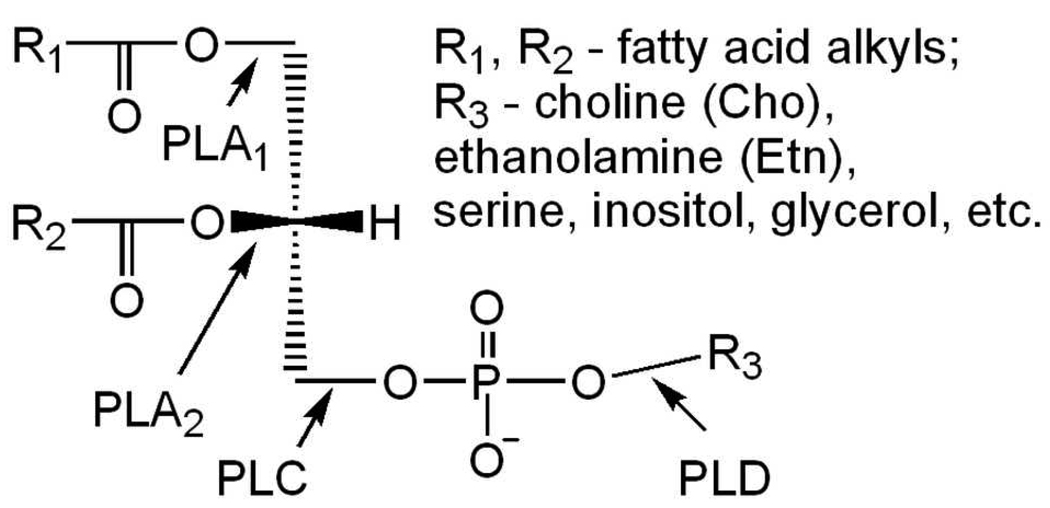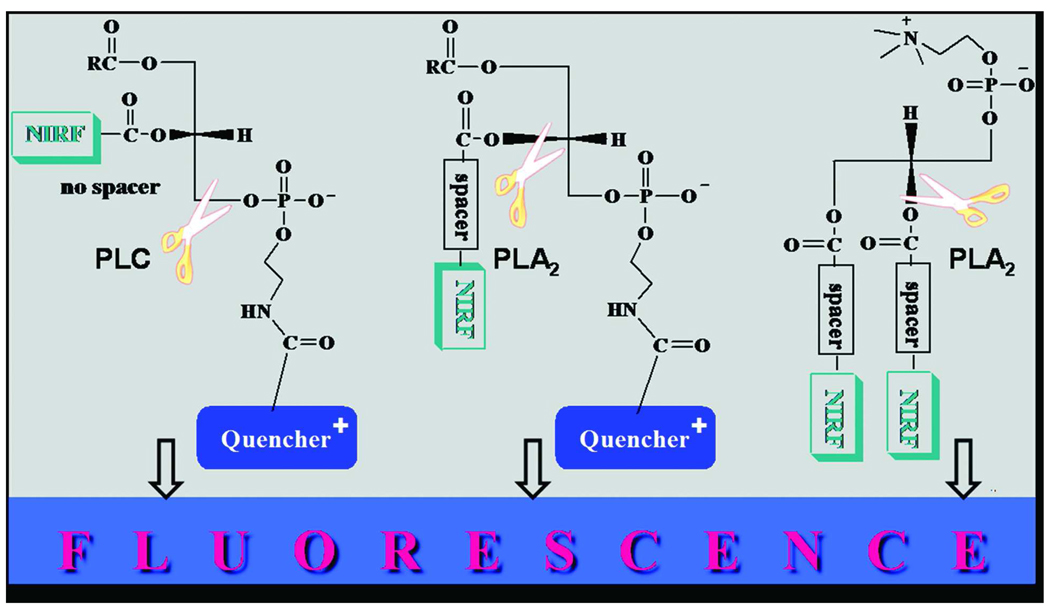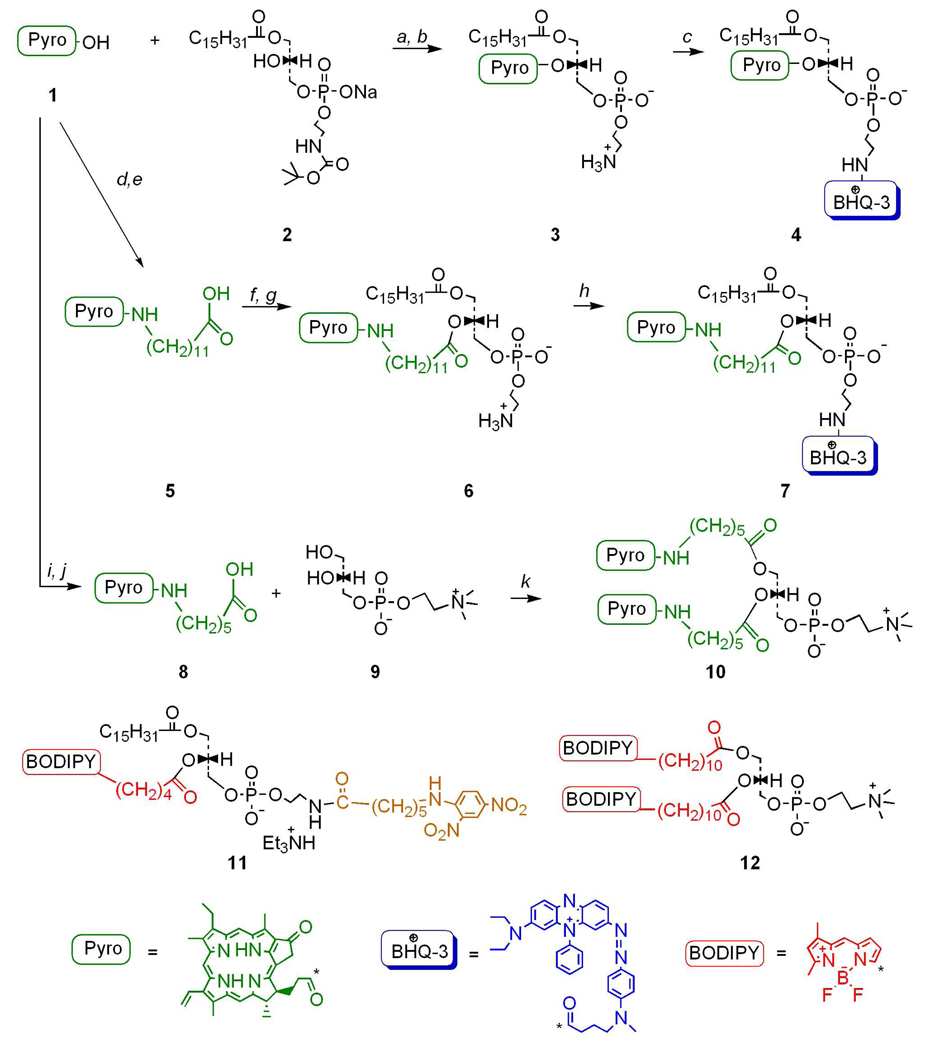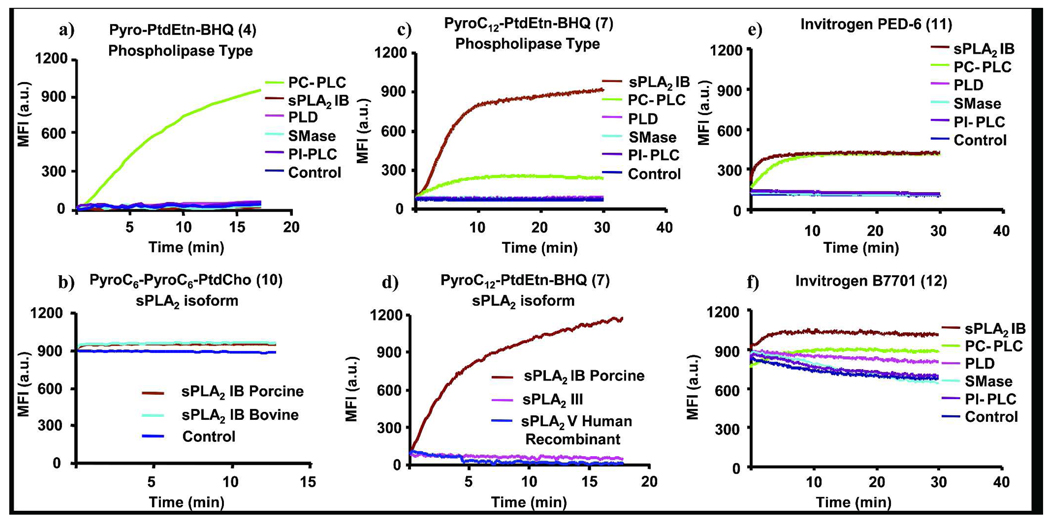Abstract
The primary focus of this work was to develop activatable probes suitable for in vivo detection of phospholipase activity. Phospholipases (PLs) are ubiquitous enzymes that perform a number of critical regulatory functions. They catalyze phospholipid breakdown and are categorized as A1, A2 (PLA2), C (PLC) and D (PLD) based on their site of action. Here we report the design, synthesis and characterization of self-quenching reporter probes that release fluorescent moieties upon cleavage with PLA2 or PLC. A series of phospholipids were synthesized bearing the NIR fluorophore Pyropheophorbide a (Pyro) at the sn-2 position. Fluorescence quenching was achieved by attachment of either a positively charged Black Hole Quencher-3 (BHQ-3) to the phospholipid head group or another neutral Pyro moiety at the sn-1 position. The specificity to different phospholipases was modulated by insertion of spacers (C6, C12) between Pyro and the lipid backbone. The specificity of the quenched fluorescent phospholipids were assayed on a plate reader against a number of phospholipases and compared with two commercial probes bearing the visible fluorophore BODIPY. While PyroC6-PyroC6-PtdCho revealed significant background fluorescence, and a 10% fluorescence increase under the action of PLA2, Pyro-PtdEtn-BHQ demonstrated high selective sensitivity to PLC, particularly to the PC-PLC isoform, and its sensitivity to PLA2 was negligible due to steric hindrance at the sn-2 position. In contrast, the C12-spacered PyroC12-PtdEtn-BHQ demonstrated a remarkable selectivity for PLA2 and the best relative PLA2/PLC sensitivity, significantly outperforming previously known probes. These results open an avenue for future in vivo experiments and for new probes to detect PL activity.
Phospholipases (PLs) are ubiquitous enzymes that perform a number of critical regulatory functions. They catalyze phospholipid breakdown and are categorized as A1, A2 (PLA2), C (PLC) and D (PLD) based on their site of action (1, 2) (Figure 1).
Figure 1.
Phospholipase-mediated cleavage sites.
Since PLA2 is elevated in a number of diseases (e.g. prostate and breast cancer, rheumatoid arthritis, etc) (3–5) we have chosen to develop probes that distinguish PLA2 from other PLs. In addition, since increased PLC is detected in melanoma, ovarian and breast cancers and PLC has been implicated in maintaining the high levels of phosphocholine (PC) and phosphoethanolamine (PE) characteristic of many human tumors (6–10), we are also developing probes to specifically detect the actions of this enzyme.
The primary focus of this work is to develop methods to investigate the expression and activity of PLs in vivo in mammals. The above diseases can be detected, monitored and in some cases treated using soft tissue penetrating near infrared (NIR) light (11, 12). As a result we are employing optical imaging using NIR fluorophores (NIRF).
Our approach is to design self-quenching reporter probes that release fluorescent moieties only upon cleavage with PLA2 or PLC. The structures of these smart probes are depicted in Figure 2. The hypothesis is that a bulky porphyrin moiety attached at the sn-2 position without a spacer would sterically hinder PLA2 activity while leaving open the PLC cleavage site, whereas incorporation of spacers of different length will make the C-O bond at the sn-2-position accessible for PLA2 mediated hydrolysis. We have chosen Pyropheophorbide a (Pyro, 1, λabs = 675 nm, λem = 725 nm) (13, 14) as a NIRF. For quenchers, we employ either the positively charged Black Hole Quencher-3 (BHQ-3) (13, 14) attached to the head group of the phospholipid or another neutral Pyro moiety at the sn-1 position.
Figure 2.
Design of NIRF-bearing PLC- and PLA2-cleavable self quenched phospholipids.
Scheme 1 demonstrates the synthesis of three self-quenched Pyro-bearing probes 4, 7 and 10. NIRF acid 1 was coupled with N-BOC Lyso-phosphatidylethanolamine (Lyso-PtdEtn, 2) under basic conditions in order to conserve the steric configuration at the sn-2 site and avoid racemization (15, 16). Next TFA-mediated BOC-deprotection resulted in the permanently fluorescent Pyro-PtdEtn (3). In the final step BHQ-3 was attached to the amino group of lipid 3 resulting in a self-quenching Pyro-PtdEtn-BHQ (4). To incorporate spacers we have synthesized PyroC12- (5) and PyroC6- (8) acids. Acid 5 was used as described above with acid 1 for production of the permanent lipid fluorophore PyroC12-PtdEtn (6), which was then converted into its self-quenched derivative (7). Two molecules of acid 8 were conjugated with sn-glycero-3-phosphocholine (9) to give rise to PyroC6-PyroC6-PtdCho (10) where self-quenching is achieved by interactions between the two NIRFs.
Scheme 1.
Synthesis of Pyro-PtdEtn-BHQ (4), PyroC12-PtdEtn-BHQ (7) and PyroC6-PyroC6-PtdCho (10) and structures for comparison of commercially available self-quenched PLA2-sensitive green fluorescent phospholipid probes PED-6 (11) and B7701 (12).
* Attachment sites for fluorophores/quencher.
Reagents, conditions (all reactions were performed under Ar in dark) and isolated yields (relative to starting NIRF 1, one arrow indicates one-pot reaction): (a) EDC, DMAP, DCM, rt, 72 h; (b) TFA, DCM, 0 °C, 4 h, 20%; (c) BHQ-3+SU PF6-, TEA, DCM, rt, 12 h, 15%; (d) NHS, EDC, DMAP, DCM, rt, 3 h; (e) H2N(CH2)11CO2H, TEA, DCM, rt, 72 h, 85% (f) 2, EDC, DMAP, DCM, rt, 72 h; (g) TFA, DCM, 0 °C, 4 h, 15%; (h) BHQ-3+SU PF6-, TEA, DCM, rt 12 h, 10%; (i) NHS, EDC, DMAP, DCM, rt, 3 h; (j) H2N(CH2)5CO2H, TEA, DCM, rt, 72 h, 75%; (k) EDC, DMAP, DCM, 40 °C, 85 h, 8%
Farber et al. had demonstrated that PLA2 activity can be detected by visual fluorescence in transparent zebra fish larvae (17, 18). These and other probes are now available commercially (Scheme 1, compounds 11, 12). The sensitivity of those phospholipids 11, 12 to PLs other than PLA2 was not tested at that time. As seen from Scheme 1 compounds 4, 7 and 11 have a fluorophore attached at the sn-2 position and a quencher bound to the nitrogen atom of the PE head. Compounds 10 and 12 exploit self-quenching of two of the same fluorophores attached to the sn-1 and sn-2 positions.
We have tested our three self-quenched probes 4, 7 and 10 as well as commercial probes 11 and 12 as substrates for different phospholipases. The results are presented in Figure 3. Probe 4 revealed high selective sensitivity to PLC, particularly to the PC-PLC isoform (Fig. 3a), while sensitivity to other tested phospholipases including PLA2 is negligible. NIRF compounds 10 and 7 were tested as potential PLA2-sensitive probes in comparison with their visible counterparts 12 and 11, respectively. PtdCho 10 revealed significant background fluorescence (Fig. 3b) because both substituents at sn-1 and sn-2 positions are self-fluorescent and their quenching efficiency is not high. Only a modest (10%) fluorescence increase was detected under the action of PLA2, similar to those observed for the visible analog 12 (Fig. 3f). In contrast the C12-spacered PtdEtn 7 demonstrated a remarkable selectivity for PLA2 (Fig. 3c) and the best relative PLA2/PLC sensitivity, significantly outperforming the magnitude of the best previously known probe 11 (Fig. 3e). Moreover, this construct exhibited significant PLA2 isoform specificity with Porcine sPLA2 IB demonstrating the highest activity (Fig. 3d).
Figure 3.
Sensitivity of self-quenched fluorescent probes to different phospholipase isoforms as measured by fluorescence release on a plate reader (See Supporting Information).
PC-PLC was able to cleave Pyro-PtdEtn-BHQ 4 and PED-6 11 even though relatively bulky quencher moieties were attached to the head group. PC-PLC, in contrast to its name, has a relatively broad range of head group specificities. It has been shown to be effective at hydrolyzing phospholipids other than PtdCho, including PtdEtn and PtdSer with relative specificities of 10:7:1 (19–22). PyroC12-PtdEtn-BHQ 7 and PED-6 11 on the other hand were both effectively cleaved by porcine sPLA2 IB. For sPLA2s, cleavage specificities are primarily due to differences in binding to the vesicle surface. sPLA2s, including sPLA2 IB bind tightly and act preferentially on anionic phospholipid vesicles (PtdGro, PtdEtn and PtdSer) compared to charge-neutral PtdCho vesicles. The isoforms of sPLA2 III and V employed on the other hand, will hydrolyze both anionic phospholipids and PtdCho. (23–26). Their inactivity to PyroC12-PtdEtn-BHQ 7 may be a result of the bulky BHQ head group, but variations in chain length may also play a role as discussed below. SMase and PI-PLC are highly head-group specific to their substrates (27–30). Table 1 in the Supporting Information contains additional information on the enzymes employed here and their substrate specificities.
Our results showed that increasing the chain length in the sn-2 position conferred increased sensitivity to sPLA2 IB but decreased sensitivity to PC-PLC. Although fatty acid composition is relatively unimportant in determining sPLA2 specificity (24), the presence of bulky substituents in the sn-1 position will lessen the enzymatic activity due to steric hindrance (31). It has also been shown sPLA2 activity is dependent on the sn-2 fatty acid chain length, which must be 7 carbons or greater, with optimal activity obtained with chain lengths between 16 and 21 carbons (32–34). The chain length requirements are not so important for PC-PLC, which contains a shallow cleft for phospholipid docking (32–35).
The phospholipase-sensitive probes described here are highly lipophilic and we have employed egg-yolk PtdCho vesicles to solubilize them (see Supporting Information). For in vivo experiments, similar techniques will be required either using micelles or liposomes for delivery. Liposomal formulations for drug delivery are well established (36) and more lipophilic molecules are often processed and excreted through the liver and stool.
In conclusion, we have designed, synthesized and tested for the first time near-infrared self-quenched phospholipid probes that reveal high sensitivity to PLC and PLA2. These results open an avenue for in vivo experiments with mammals and for the development of sensitive new probes to detect PL activity.
Supplementary Material
ACKNOWLEDGMENT
Financial support was provided by the NIH (grants R01-CA114347 (EJD), R01-CA129176 (EJD), and U24-CA083105 Penn Small Animal Imaging Resource) and DoD (W81XWH-08-1-0716 (AVP)).
Footnotes
Supporting Information Available: Experimental procedures and characterization. This material is available free of charge via the Internet at http://pubs.acs.org.
LITERATURE CITED
- 1.Hanahan DJ. A Guide to Phospholipid Chemistry. New York: Oxford University Press; 1997. [Google Scholar]
- 2.Wilton DC. Phospholipases. In: Vance DE, Vance JE, editors. Biochemistry of Lipids, Lipoproteins and Membranes. 5th Ed. Elsevier Science; 2008. pp. 305–329. [Google Scholar]
- 3.Stefanski E, Pruzanski W, Sternby B, Vadas P. Purification of a soluble phospholipase A2 from synovial fluid in rheumatoid arthritis. J. Biochem. 1986;100:1297–1303. doi: 10.1093/oxfordjournals.jbchem.a121836. [DOI] [PubMed] [Google Scholar]
- 4.Sved P, Scott KF, McLeod D, King NJC, Singh J, Tsatralis T, Nikolov B, Boulas J, Nallan L, Gelb MH, Sajinovic M, Graham GG, Russell PJ, Dong Q. Oncogenic action of secreted phospholipase A2 in prostate cancer. Cancer Res. 2004;64:6934–6940. doi: 10.1158/0008-5472.CAN-03-3018. [DOI] [PubMed] [Google Scholar]
- 5.Yamashita S-i, Ogawa M, Sakamoto K, Abe T, Arakawa H, Yamashita J-i. Elevation of serum group II phospholipase A2 levels in patients with advanced cancer. Clin. Chim. Acta. 1994;228:91–99. doi: 10.1016/0009-8981(94)90280-1. [DOI] [PubMed] [Google Scholar]
- 6.Degani H, DeJordy JO, Salomon Y. Stimulation of cAMP and phosphomonoester production by melanotropin in melanoma cells: phosphorus-31 NMR studies. Proc. Natl. Acad. Sci. U. S. A. 1991;88:1506–1510. doi: 10.1073/pnas.88.4.1506. [DOI] [PMC free article] [PubMed] [Google Scholar]
- 7.Iorio E, Ricci A, Bagnoli M, Pisanu ME, Castellano G, Di Vito M, Venturini E, Glunde K, Bhujwalla ZM, Mezzanzanica D, Canevari S, Podo F. Activation of Phosphatidylcholine Cycle Enzymes in Human Epithelial Ovarian Cancer Cells. Cancer Res. 2010;70:2126–2135. doi: 10.1158/0008-5472.CAN-09-3833. [DOI] [PMC free article] [PubMed] [Google Scholar]
- 8.Paris L, Cecchetti S, Spadaro F, Abalsamo L, Lugini L, Pisanu ME, Iorio E, Natali PG, Ramoni C, Podo F. Inhibition of phosphatidylcholine-specific phospholipase C downregulates HER2 overexpression on plasma membrane of breast cancer cells. Breast Cancer Res. 2010;12 doi: 10.1186/bcr2575. Published online 05.12.2010; doi:10.1186/bcr2575. [DOI] [PMC free article] [PubMed] [Google Scholar]
- 9.Soderquist AM, Todderud G, Carpenter G. Elevated membrane association of phospholipase C-gamma 1 in MDA-468 mammary tumor cells. Cancer Res. 1992;52:4526–4529. [PubMed] [Google Scholar]
- 10.Spadaro F, Ramoni C, Mezzanzanica D, Miotti S, Alberti P, Cecchetti S, Iorio E, Dolo V, Canevari S, Podo F. Phosphatidylcholine-Specific Phospholipase C Activation in Epithelial Ovarian Cancer Cells. Cancer Res. 2008;68:6541–6549. doi: 10.1158/0008-5472.CAN-07-6763. [DOI] [PubMed] [Google Scholar]
- 11.Mahmood U, Weissleder R. Near-infrared optical imaging of proteases in cancer. Mol. Cancer Ther. 2003;2:489–496. [PubMed] [Google Scholar]
- 12.Ntziachristos V, Bremer C, Weissleder R. Fluorescence imaging with near-infrared light: new technological advances that enable in vivo molecular imaging. Eur Radiol. 2003;13:195–208. doi: 10.1007/s00330-002-1524-x. [DOI] [PubMed] [Google Scholar]
- 13.Lo P-C, Chen J, Stefflova K, Warren Michael S, Navab R, Bandarchi B, Mullins S, Tsao M, Cheng Jonathan D, Zheng G. Photodynamic molecular beacon triggered by fibroblast activation protein on cancer-associated fibroblasts for diagnosis and treatment of epithelial cancers. J Med Chem. 2009;52:358–368. doi: 10.1021/jm801052f. [DOI] [PMC free article] [PubMed] [Google Scholar]
- 14.Stefflova K, Chen J, Li H, Zheng G. Targeted photodynamic therapy agent with a built-in apoptosis sensor for in vivo near-infrared imaging of tumor apoptosis triggered by its photosensitization in situ. Mol Imaging. 2006;5:520–532. [PubMed] [Google Scholar]
- 15.Lindberg J, Ekeroth J, Konradsson P. Efficient Synthesis of Phospholipids from Glycidyl Phosphates. J. Org. Chem. 2002;67:194–199. doi: 10.1021/jo010734+. [DOI] [PubMed] [Google Scholar]
- 16.Rosseto R, Bibak N, DeOcampo R, Shah T, Gabrielian A, Hajdu J. A New Synthesis of Lysophosphatidylcholines and Related Derivatives. Use of p-Toluenesulfonate for Hydroxyl Group Protection. J. Org. Chem. 2007;72:1691–1698. doi: 10.1021/jo062352f. [DOI] [PubMed] [Google Scholar]
- 17.Farber SA, Pack M, Ho S-Y, Johnson LD, Wagner DS, Dosch R, Mullins MC, Hendrickson HS, Hendrickson EK, Halpern ME. Genetic analysis of digestive physiology using fluorescent phospholipid reporters. Science (Washington, DC, U. S.) 2001;292:1385–1388. doi: 10.1126/science.1060418. [DOI] [PubMed] [Google Scholar]
- 18.Hendrickson HS, Hendrickson EK, Johnson ID, Farber SA. Intramolecularly Quenched BODIPY-Labeled Phospholipid Analogs in Phospholipase A2 and Platelet-Activating Factor Acetylhydrolase Assays and in Vivo Fluorescence Imaging. Anal. Biochem. 1999;276:27–35. doi: 10.1006/abio.1999.4280. [DOI] [PubMed] [Google Scholar]
- 19.Antikainen NM, Hergenrother PJ, Harris MM, Corbett W, Martin SF. Altering Substrate Specificity of Phosphatidylcholine-Preferring Phospholipase C of Bacillus cereus by Random Mutagenesis of the Headgroup Binding Site. Biochemistry. 2003;42:1603–1610. doi: 10.1021/bi0267285. [DOI] [PubMed] [Google Scholar]
- 20.Benfield AP, Goodey NM, Phillips LT, Martin SF. Structural studies examining the substrate specificity profiles of PC-PLCBc protein variants. Arch. Biochem. Biophys. 2007;460:41–47. doi: 10.1016/j.abb.2007.01.023. [DOI] [PMC free article] [PubMed] [Google Scholar]
- 21.Hergenrother PJ, Martin SF. Determination of the kinetic parameters for phospholipase C (Bacillus cereus) on different phospholipid substrates using a chromogenic assay based on the quantitation of inorganic phosphate. Anal Biochem. 1997;251:45–49. doi: 10.1006/abio.1997.2251. [DOI] [PubMed] [Google Scholar]
- 22.Hergenrother PJ, Martin SF. Phosphatidylcholine-preferring phospholipase C from B. cereus. function, structure, and mechanism. Top. Curr. Chem. 2001;211:131–167. [Google Scholar]
- 23.Kudo I, Murakami M. Phospholipase A2 enzymes. Prostaglandins Other Lipid Mediators. 2002;68–69:3–58. doi: 10.1016/s0090-6980(02)00020-5. [DOI] [PubMed] [Google Scholar]
- 24.Murakami M, Kudo I. Diversity and regulatory functions of mammalian secretory phospholipase A2s. Adv. Immunol. 2001;77:163–194. doi: 10.1016/s0065-2776(01)77017-4. [DOI] [PubMed] [Google Scholar]
- 25.Murakami M, Kudo I. Lipid signaling. Phospholipase A2. J. Biochem. 2002;131:285–292. doi: 10.1093/oxfordjournals.jbchem.a003101. [DOI] [PubMed] [Google Scholar]
- 26.Kinkaid A, Wilton DC. Comparison of the catalytic properties of phospholipase A2 from pancreas and venom using a continuous fluorescence displacement assay. Biochem. J. 1991;278:843–848. doi: 10.1042/bj2780843. [DOI] [PMC free article] [PubMed] [Google Scholar]
- 27.Berg OG, Yu B-Z, Apitz-Castro RJ, Jain MK. Phosphatidylinositol-Specific Phospholipase C Forms Different Complexes with Monodisperse and Micellar Phosphatidylcholine. Biochemistry. 2004;43:2080–2090. doi: 10.1021/bi035063j. [DOI] [PubMed] [Google Scholar]
- 28.Ikezawa H, Yamanegi M, Taguchi R, Miyashita T, Ohyabu T. Studies on phosphatidylinositol phosphodiesterase (phospholipase C type) of Bacillus cereus. I. Purification, properties and phosphatase-releasing activity. Biochim. Biophys. Acta, Lipids Lipid Metab. 1976;450:154–164. [PubMed] [Google Scholar]
- 29.Ryan M, Liu T, Dahlquist FW, Griffith OH. A Catalytic Diad Involved in Substrate-Assisted Catalysis: NMR Study of Hydrogen Bonding and Dynamics at the Active Site of Phosphatidylinositol-Specific Phospholipase C. Biochemistry. 2001;40:9743–9750. doi: 10.1021/bi010958m. [DOI] [PubMed] [Google Scholar]
- 30.Tomita M, Sawada H, Taguchi R, Ikezawa H. The action of sphingomyelinase from Bacillus cereus on ATP-depleted bovine erythrocyte membranes and different lipid composition of liposomes. Arch. Biochem. Biophys. 1987;255:127–135. doi: 10.1016/0003-9861(87)90302-x. [DOI] [PubMed] [Google Scholar]
- 31.Linderoth L, Peters GH, Jorgensen K, Madsen R, Andresen TL. Synthesis of sn-1 functionalized phospholipids as substrates for secretory phospholipase A2. Chem. Phys. Lipids. 2007;146:54–66. doi: 10.1016/j.chemphyslip.2006.12.006. [DOI] [PubMed] [Google Scholar]
- 32.Caramelo JJ, Florin-Christensen J, Florin-Christensen M, Delfino JM. Mapping the catalytic pocket of phospholipases A2 and C using a novel set of phosphatidylcholines. Biochem. J. 2000;346:679–690. [PMC free article] [PubMed] [Google Scholar]
- 33.Lewis KA, Bian J, Sweeney A, Roberts MF. Asymmetric short-chain phosphatidylcholines: defining chain binding constraints in phospholipases. Biochemistry. 1990;29:9962–9970. doi: 10.1021/bi00494a029. [DOI] [PubMed] [Google Scholar]
- 34.Soltys CE, Bian J, Roberts MF. Polymerizable phosphatidylcholines: Importance of phospholipid motions for optimum phospholipase A2 and C activity. Biochemistry. 1993;32:9545–9552. doi: 10.1021/bi00088a005. [DOI] [PubMed] [Google Scholar]
- 35.El-Sayed MY, DeBose CD, Coury LA, Roberts MF. Sensitivity of phospholipase C (Bacillus cereus) activity to phosphatidylcholine structural modifications. Biochim. Biophys. Acta, Lipids Lipid Metab. 1985;837:325–335. doi: 10.1016/0005-2760(85)90056-6. [DOI] [PubMed] [Google Scholar]
- 36.Torchilin VP, Weissig V. Liposomes, Second Edition: A Practical Approach. New York: Oxford University Press; 2003. [Google Scholar]
Associated Data
This section collects any data citations, data availability statements, or supplementary materials included in this article.






